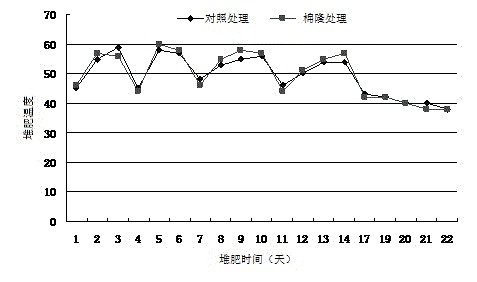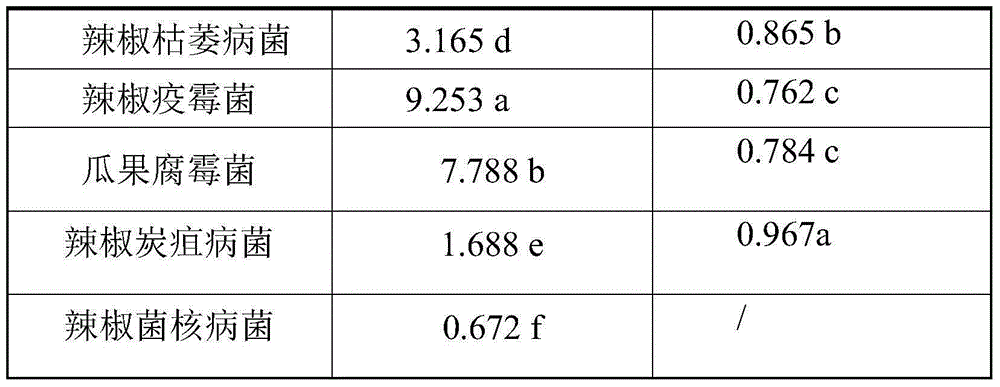Method for efficiently killing pathogenic bacteria in vegetable wrack compost
A technology of vegetable residues and pathogenic bacteria, applied in the field of comprehensive utilization of agricultural waste, can solve the problems of no plant pathogenic bacteria, and achieve the effects of accelerating decomposition and nutrient transformation, environmental protection and inhibition, and simple application process
- Summary
- Abstract
- Description
- Claims
- Application Information
AI Technical Summary
Problems solved by technology
Method used
Image
Examples
Embodiment 1
[0019] Embodiment 1: The growth inhibitory action test of cotton long to common phytopathogenic fungi hyphae and spores
[0020] Inoculate 6 kinds of pathogenic fungi: Rhizoctonia solani, Pythium solani, Fusarium wilt of pepper, Phytophthora capsici, Anthracnose capsicum, Sclerotinia sclerotiorum into PDA plate culture medium respectively, culture at 28-30°C for 5 days and use The mycelium block with a diameter of 5mm is obtained by punching a hole for subsequent use.
[0021] (1) Metron's inhibition test on mycelia growth of common plant pathogenic fungi
[0022] Inoculate the mycelia blocks of 6 kinds of pathogenic fungi in the middle of the PDA plate culture medium respectively (at this moment, the gas space volume in the petri dish is 63.7cm 3 ), add a certain amount of cotton wool to the center of the petri dish cover, so that the concentration of cotton wool in the gas space in the petri dish is 0, 0.2, 0.4, 0.6, 1, 2, 6, 10 mg / L and then add cotton wool Sterile water ...
Embodiment 2
[0034] Example 2 The killing effect test of Mironon in the composting of vegetable residues to Sclerotinia sclerotiorum of pepper
[0035] Time: September 2014;
[0036] Location: Liuhe Animal Science Base, Jiangsu Academy of Agricultural Sciences;
[0037] Use a pulverizer to crush the pepper plants harvested from the pepper fruits to 5-8 cm as compost materials. When the ambient temperature is above 15°C, measure the carbon-nitrogen ratio of the compost materials according to the standard NY884-2012 of the Ministry of Agriculture, and the result is 21. Determine according to the measurement results Add 0.5% (w / w) bran in the vegetable residue, adjust the carbon-to-nitrogen ratio to be 28, measure the water content of the material to be 67%, then evenly add cotton wool, the dosage form is 98% wettable powder, and the addition is 0.15 kg per cubic meter, stir quickly and evenly, and then stack the materials into 5 circular piles with a bottom diameter of 1.5 meters and a heig...
Embodiment 3
[0042] Embodiment 3 Vegetable residues are sterilized and decomposed
[0043] Use a pulverizer to grind the pepper plants harvested from the pepper fruits to 5-8 cm as compost materials. When the ambient temperature is above 15°C, measure the carbon-nitrogen ratio of the compost materials according to the standard NY884-2012 of the Ministry of Agriculture, and adjust the vegetable residues according to the measurement results. The carbon-to-nitrogen ratio of the body is 28, and the water content of the measured material is 67%, and then evenly add cotton wool, the dosage form is 98% wettable powder, the addition amount is 0.15kg per cubic meter, stir quickly and evenly, and then pile the material into the bottom A circular pile with a diameter of 1.5 meters and a height of 1 meter is covered with a plastic film with a thickness of 0.05 cm. The bottom of the film is pressed into the bottom of the pile close to the ground to ensure that the surroundings of the pile are well seale...
PUM
| Property | Measurement | Unit |
|---|---|---|
| thickness | aaaaa | aaaaa |
Abstract
Description
Claims
Application Information
 Login to View More
Login to View More - R&D
- Intellectual Property
- Life Sciences
- Materials
- Tech Scout
- Unparalleled Data Quality
- Higher Quality Content
- 60% Fewer Hallucinations
Browse by: Latest US Patents, China's latest patents, Technical Efficacy Thesaurus, Application Domain, Technology Topic, Popular Technical Reports.
© 2025 PatSnap. All rights reserved.Legal|Privacy policy|Modern Slavery Act Transparency Statement|Sitemap|About US| Contact US: help@patsnap.com



